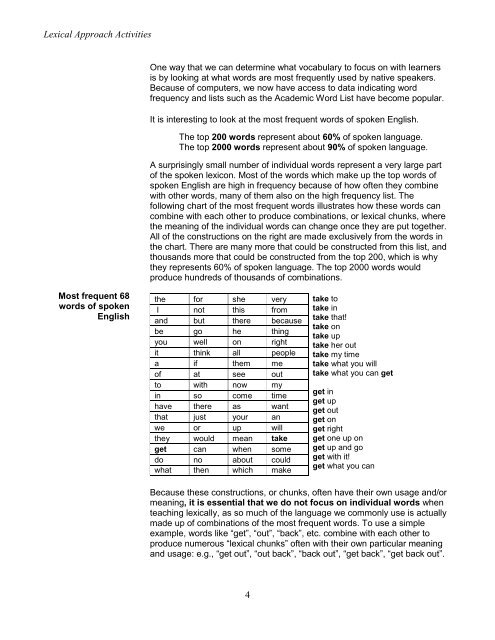Lexical Approach Activities - Ken Lackman
Lexical Approach Activities - Ken Lackman
Lexical Approach Activities - Ken Lackman
You also want an ePaper? Increase the reach of your titles
YUMPU automatically turns print PDFs into web optimized ePapers that Google loves.
<strong>Lexical</strong> <strong>Approach</strong> <strong>Activities</strong><br />
Most frequent 68<br />
words of spoken<br />
English<br />
One way that we can determine what vocabulary to focus on with learners<br />
is by looking at what words are most frequently used by native speakers.<br />
Because of computers, we now have access to data indicating word<br />
frequency and lists such as the Academic Word List have become popular.<br />
It is interesting to look at the most frequent words of spoken English.<br />
The top 200 words represent about 60% of spoken language.<br />
The top 2000 words represent about 90% of spoken language.<br />
A surprisingly small number of individual words represent a very large part<br />
of the spoken lexicon. Most of the words which make up the top words of<br />
spoken English are high in frequency because of how often they combine<br />
with other words, many of them also on the high frequency list. The<br />
following chart of the most frequent words illustrates how these words can<br />
combine with each other to produce combinations, or lexical chunks, where<br />
the meaning of the individual words can change once they are put together.<br />
All of the constructions on the right are made exclusively from the words in<br />
the chart. There are many more that could be constructed from this list, and<br />
thousands more that could be constructed from the top 200, which is why<br />
they represents 60% of spoken language. The top 2000 words would<br />
produce hundreds of thousands of combinations.<br />
the for she very take to<br />
I not this from<br />
and but there because<br />
be go he thing<br />
you well on right<br />
it think all people<br />
a if them me<br />
of at see out<br />
to with now my<br />
in so come time<br />
have there as want<br />
that just your an<br />
we or up will<br />
they would mean take<br />
get can when some<br />
do no about could<br />
what then which make<br />
4<br />
take in<br />
take that!<br />
take on<br />
take up<br />
take her out<br />
take my time<br />
take what you will<br />
take what you can get<br />
get in<br />
get up<br />
get out<br />
get on<br />
get right<br />
get one up on<br />
get up and go<br />
get with it!<br />
get what you can<br />
Because these constructions, or chunks, often have their own usage and/or<br />
meaning, it is essential that we do not focus on individual words when<br />
teaching lexically, as so much of the language we commonly use is actually<br />
made up of combinations of the most frequent words. To use a simple<br />
example, words like “get”, “out”, “back”, etc. combine with each other to<br />
produce numerous “lexical chunks” often with their own particular meaning<br />
and usage: e.g., “get out”, “out back”, “back out”, “get back”, “get back out”.


